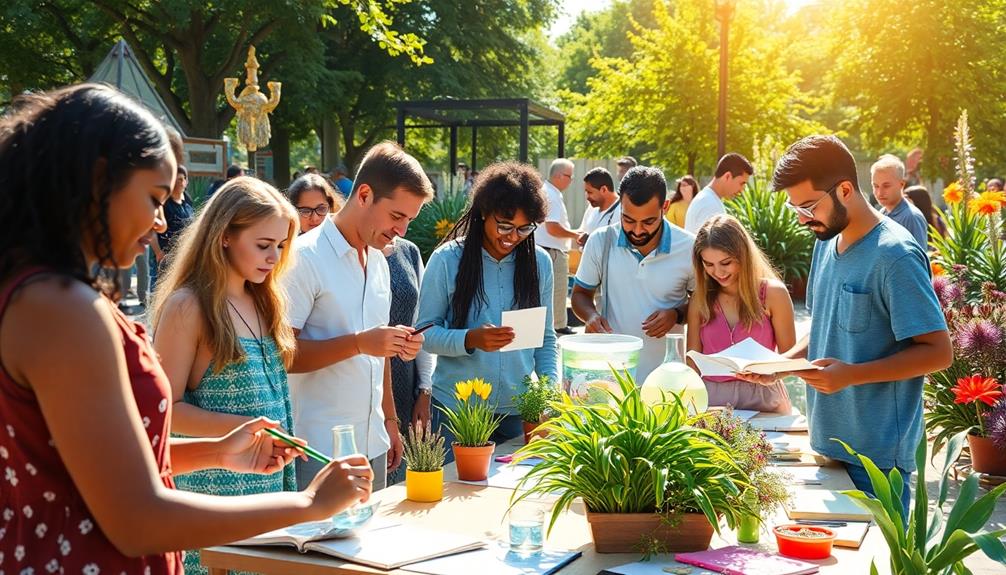Curiosity is a powerful spark for innovation in everyday life. When you ask questions and explore new ideas, you challenge norms and release your creativity. This mindset not only enhances problem-solving skills but also boosts engagement and satisfaction. By fostering a culture of curiosity, whether at home or work, you can generate groundbreaking solutions to daily challenges. Embracing uncertainty and seeing failures as learning opportunities can transform how you approach tasks. So, if you're curious about practical ways to nurture this mindset, there's much more to discover on how curiosity can drive your innovation journey.
Key Takeaways
- Curiosity encourages asking "What if?" questions, leading to creative problem-solving and innovative solutions in daily situations.
- Engaging in open-ended inquiries fosters a culture of continuous learning, enhancing adaptability in everyday challenges.
- Collaborative brainstorming sessions fueled by curiosity generate diverse ideas, driving innovation in team settings.
- Embracing uncertainty and viewing failure as a learning opportunity promotes experimentation and creativity in daily life.
- Recognizing and rewarding curiosity-driven actions motivates individuals to explore new ideas and improve their performance.
The Essence of Curiosity

Curiosity is the spark that ignites creativity and drives innovation. When you embrace curiosity, you open the door to new ideas, enabling you to challenge existing assumptions. This exploration often leads to breakthroughs that can transform various fields, from technology to art.
Research shows that curious individuals tend to engage in lifelong learning, boosting their problem-solving skills and critical thinking. As you adapt to changing environments, your curiosity becomes an essential asset.
Curiosity and Happiness illustrates how engaging with new experiences can lead to a more fulfilling life, highlighting the positive impact of curiosity on overall well-being.
Interestingly, a survey reveals that while 83% of C-suite executives promote curiosity within their organizations, only 50% notice it in practice. This gap highlights the importance of not just encouraging curiosity but actively implementing it.
The act of questioning—asking "What if?" or "How come?"—fuels exploration and reflective thinking, significant for both personal and professional growth.
Moreover, curiosity enhances memory, empathy, effort, and persistence, all contributing to improved performance and satisfaction. By cultivating your curiosity, you'll find that it not only enriches your experiences but also amplifies your creativity and innovation.
Curiosity Fuels Innovation

Embracing a curious mindset can lead you to innovative solutions that transform your work and the world around you. Curiosity drives you to explore new ideas and possibilities, pushing you toward creative breakthroughs.
When you ask questions and seek alternative solutions, you challenge existing assumptions, which can result in a deeper understanding of problems. By recognizing the importance of personal values in driving behavior, you can further enhance your curiosity and creativity.
Research shows that organizations that foster a culture of curiosity experience higher employee engagement and overall innovation. When you prioritize curiosity in your work environment, you not only enhance your creativity but also improve adaptability, leading to increased market share and competitiveness.
Think about historical innovations like the internet or renewable energy technologies; they originated from simple yet profound questions that stemmed from curiosity. By engaging in curiosity-driven inquiry, you empower yourself and your team to think outside the box, generating innovative ideas that can revolutionize your field.
In a rapidly changing world, harnessing the power of curiosity can be the key to staying ahead. So, embrace that curiosity, and watch how it fuels your journey toward innovation.
Strategies for Fostering Curiosity

A thriving culture of curiosity can greatly enhance innovation within your organization. To foster this environment, start by encouraging open-ended questions during discussions. This approach stimulates deeper thinking and exploration, allowing new ideas to flourish.
Regular brainstorming sessions are another effective strategy; they enhance collaboration as team members share diverse perspectives and build on each other's contributions. Additionally, integrating data-driven marketing strategies can help to inform and inspire creative solutions by grounding ideas in measurable outcomes.
Cross-disciplinary collaboration is key too. By providing opportunities for employees from different fields to work together, you enrich problem-solving processes, bringing unique insights to the table.
Recognizing and rewarding curiosity-driven initiatives within your organization can also motivate your team to engage actively in innovative thinking. When employees see that their inquisitive efforts are valued, they're more likely to contribute.
Lastly, cultivate an environment where failure is viewed as a learning opportunity. This mindset encourages individuals to take risks and experiment, often leading to unexpected breakthroughs.
The Role of Questions

Fostering a culture of curiosity sets the stage for a powerful tool: questions. When you encourage inquiry, you're challenging existing assumptions and norms, which often sparks innovative ideas and solutions. Think about how groundbreaking advancements like the internet and solar panels started from simple questions. Curiosity-driven questioning can lead to significant innovations that change our world.
Asking "What if?" is a key strategy to foster deeper exploration and understanding. This process is essential for stimulating creativity and enhancing your problem-solving abilities. When you engage in regular inquiry, you cultivate not just a culture of innovation but also improve collaboration and teamwork. Sharing diverse perspectives enriches the discussion and leads to better outcomes.
Organizations that promote open-ended questions often witness improved employee engagement and satisfaction. Curiosity-driven environments foster continuous learning and adaptability, essential traits in today's fast-paced world.
Curiosity's Impact on Society

Curiosity drives societal progress by sparking innovation across diverse fields, from healthcare to technology.
When you foster collaborative environments, you create spaces where new ideas can flourish, leading to breakthroughs that benefit everyone.
Embracing curiosity isn't just about personal growth; it's essential for tackling the challenges our society faces today.
Curiosity Drives Societal Progress
The spark of curiosity often ignites the flames of societal progress, driving innovation that transforms our world. When you ask "What if?" or challenge the status quo, you open the door to groundbreaking advancements.
Historically, curiosity-driven innovation has led to significant societal developments, such as the internet and renewable energy technologies. These innovations not only enhance our daily lives but also address pressing global challenges like climate change and health crises.
Organizations that nurture a culture of curiosity see higher employee engagement and satisfaction, boosting overall productivity. As the future workforce increasingly prioritizes adaptability and innovative problem-solving skills, curiosity becomes fundamental in education and professional development.
It's clear that fostering curiosity is essential for preparing individuals to tackle complex societal issues.
Furthermore, collaboration between academia and industry plays an important role in harnessing curiosity for societal progress. When these sectors work together, they generate innovations that fuel economic growth and enhance competitiveness.
Innovation in Diverse Fields
While exploring diverse fields, you'll find that curiosity acts as a catalyst for innovation, driving advancements that reshape industries and improve lives.
In technology, curiosity has led to groundbreaking developments, like the internet, which transformed communication and access to information. Similarly, in healthcare, curiosity-driven research has spurred innovations in treatments and patient care, ultimately enhancing quality of life.
Environmental sustainability also showcases curiosity's impact, as inquisitive minds seek creative solutions to combat climate change. For instance, renewable energy technologies arose from challenging existing paradigms and asking bold questions.
Organizations that prioritize curiosity tend to foster creativity among their employees, resulting in higher engagement and satisfaction. This creates a competitive advantage, as curious teams are more likely to develop innovative solutions that address pressing challenges.
The collaboration between academia and industry highlights how curiosity fuels breakthroughs, ensuring continued economic growth in a rapidly changing world.
Fostering Collaborative Environments
Creating collaborative environments that prioritize curiosity can reveal innovative solutions to some of society's most pressing challenges. When you foster a culture where diverse perspectives are valued, you're not just encouraging collaboration; you're igniting curiosity that leads to groundbreaking ideas.
By promoting open dialogue and experimentation, your organization can boost creativity and employee satisfaction, making it more competitive in the market.
Curiosity-driven innovation is especially crucial in collaborative efforts between academia and industry. When researchers and practitioners join forces, they can transform curiosity-led research into practical applications that address urgent issues like climate change and health crises.
This synergy enhances problem-solving capabilities, facilitating informed decisions and better project outcomes.
Moreover, companies that embrace this culture of curiosity often see tangible benefits, including increased market share and profitability.
By developing new products and services while improving operational efficiency, they create a cycle of collaboration and innovation that fuels success.
Ultimately, when you prioritize curiosity in collaborative environments, you're not just solving problems; you're paving the way for a more innovative and resilient society.
Embracing Uncertainty in Innovation

Embracing uncertainty is essential for sparking innovation. When you step into the unknown, you're opening yourself up to new possibilities and unexpected breakthroughs. Curiosity drives you to explore uncharted territories, and it's often in those spaces that innovation thrives.
Research shows that organizations willing to take risks and view failure as a learning opportunity outshine their competitors. This curiosity-driven approach to uncertainty is key.
As you navigate uncertainty, you'll likely engage in creative problem-solving, enhancing your ability to generate innovative solutions in your daily life. Remember historical examples like the internet or solar panels; questioning existing norms and embracing the unknown led to transformative innovations.
Fostering an environment that encourages risk-taking can greatly enhance not only your engagement but also your satisfaction. When you feel empowered to explore the unfamiliar, you contribute to a culture ripe for innovation.
Frequently Asked Questions
Why Is Curiosity Important in Innovation?
Curiosity's essential for innovation because it drives you to explore new ideas and challenge the status quo.
When you ask questions and seek answers, you open doors to creative solutions and groundbreaking discoveries.
This mindset not only enhances your problem-solving skills but also encourages continuous learning.
As you embrace curiosity, you'll likely find more engagement in your work, leading to a greater sense of purpose and a richer environment for innovation.
How Is Curiosity Used in Everyday Life?
Curiosity plays an essential role in your everyday life. You ask questions like "What if?" and "How come?" to explore new ideas and solutions.
By trying new recipes or visiting unfamiliar places, you stimulate your creativity and broaden your perspective. Engaging in discussions or journaling your thoughts helps you connect with others and enhances your emotional intelligence.
When you nurture curiosity, you're more adaptable, leading to personal growth and improved performance in all areas.
What Is an Example of an Innovation Catalyst?
Imagine a world without smartphones—it's like a universe without stars!
One prime example of an innovation catalyst is the smartphone itself. You can see how it revolutionized communication by merging a phone with a computer, completely transforming how you connect with others.
This leap in technology stems from a simple question: "What if?" By embracing curiosity and questioning the status quo, you've opened the door to countless possibilities in your daily life.
Why Curiosity Is the Mother of Innovative Inventions?
Curiosity fuels innovation because it pushes you to ask questions and seek answers.
When you're curious, you explore possibilities and challenge the status quo. This mindset leads to creative solutions and inventions.
Think about how many breakthroughs started with a simple "What if?"
It's this desire to learn and understand that drives you to experiment and innovate, ultimately resulting in new technologies and ideas that can change the world around you.
Conclusion
Curiosity really is the spark that ignites innovation in our daily lives. By asking questions and embracing uncertainty, you open doors to new ideas and solutions. Remember, "curiosity killed the cat, but satisfaction brought it back." So, don't shy away from exploring the unknown; it's through your curiosity that you'll discover fresh perspectives and drive meaningful change. Embrace that inquisitive spirit, and watch how it transforms your world and the society around you.









